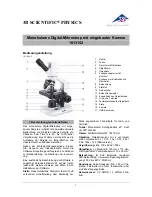
These microscopes are high precision instruments that may be used for clinical research and university studies; in
laboratories and hospitals, technological centers and research institutes. They also perform well in medical studies in
biology, bacteriology, cytology and pharmacology. Levenhuk 850B and 870T may be used for microphotography with
additional accessories. The kit of Levenhuk D870T already includes an eyepiece digital camera that allows you to observe
specimens on your PC monitor and save images on the hard drive.
This manual contains detailed information on the design and operational principles of your new microscope, as well as a
troubleshooting and care and maintenance section. It is highly recommended that you read this manual before using the
microscope for the first time. Abiding by the following instructions will ensure maximum service life of your microscope:
Never look directly at the Sun through optical devices or with the unaided eye! It can result in
permanent eye damage or even BLINDNESS.
This instrument was designed for high-power observations of various biological specimens. It should not be used for any
other purpose.
Do
not
try
to
take
this
microscope
apart
on
your
own
, as you might damage the
intricate
optical
system
within
.
If the
troubleshooting section of this manual did not contain a solution to your issue, you should contact the local Levenhuk
service center.
Always unplug the microscope from a power source before opening the base or changing the illumination lamp. Regardless
of the lamp type (halogen or incandescent), give it some time to cool down before trying to change it, and always change
it to a lamp of the same type. When using the microscope, try not to use it near flammable materials or substances
(benzene, paper, cardboard, plastic, etc.), as the base may heat up during use, and might become a fire hazard.
Always use the power supply with the proper voltage, i.e. indicated in the specifications of your new microscope. Plugging
the instrument into a different power outlet may damage the electric circuitry of the microscope, burn out the lamp, or
even cause a short circuit.
Never touch the microscope optics with your fingers, as fingerprints and smudges will significantly reduce the quality of
your views.
These microscopes perform best under the following conditions: room temperature from 0 °C to 40 °C (32-104°F), relative
humidity not exceeding 85%. High temperatures and humidity may cause lenses to fog from inside, thus damaging the
optical system.
Any microscope is a very delicate instrument, so it should be handled with care. Even
a
slight
impact
might
damage
it
.
General
Information
Light emitted from a lamp passes through the condenser and illuminates a
specimen. The image is magnified by the objective lens, refracted by the
prism and then magnified once more by the eyepiece.
Total magnification = (objective lens magnification) x (eyepiece
magnification).
The kit of these microscopes includes two WF10x eyepieces with wide
field of view:
Operating principle
Lamp
Condenser
Specimen
Objective lens
Prism
Eyepiece
Magnification
Field of view
Working distance
10x
18 mm (0.71 in)
24.95 mm (0.98 in)
EN
Biological microscopes
Levenhuk 850B
/
870T
/
D870T
The standard kit of these microscopes includes the following DIN achromatic objective lenses: 4x, 10x, 40x (spring-
loaded) and 100x (spring-loaded, oil immersion). When using the 100x objective lens, both the lens and the cover glass of
the observed specimen should be immersed in a transparent oil of high refractive index. This displaces the air and, as a
result, increases the quality of your views. If some air bubbles are still present, you may have to rotate the revolving
nosepiece once, or add some more immersion oil. Upon finishing the high-power observations, you should wipe the
objective lens and the cover glass clean. Otherwise, the oil will dry and reduce the quality of subsequent views.
Objective lenses
Принцип работы
DIN achromatic objective lens
Magnification
Aperture
Working distance
Comments
4X
4
0.1 mm
36.9 mm (1.45 in)
10X
10
0.25 mm
7.116 mm (0.28 in)
40X
40
0
.
65
mm
0.632 mm (0.025 in)
Spring-loaded
100X
100
1
.
25
mm
0.158 mm (0.006 in)
Spring-loaded, oil immersion




































